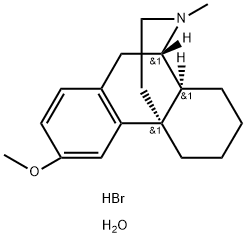Description
Dextromethorphan (DXM) is a dextratrorotatory morphinan with structural similarity to levorphanol, codeine, and morphine. Because of its strong antitussive effects, dextromethorphan is widely used as a cough suppressant. However, it does not provoke opioid activity as is characteristic of several other morphine derivatives. DXM binds to and inhibits NMDA (IC
50 = 0.55 μM) and nicotinic receptors (IC
50s = 0.7-
3.9 μM) and blocks receptor-
gated and voltage-
gated calcium channels (IC
50 = 60 μM) and voltage-
gated sodium channels (IC
50 = 78 μM). DXM has been used in multimodal analgesic therapies for acute and neuropathic pain.
Chemical Properties
White Solid
Uses
An antitussive drug. Orally active synthetic morphine analog. Analgesic (narcotic). Racemethorphan and levomethorpham are controlled substances (opiates).
Uses
Antitussive;Opioid ligand
Definition
ChEBI: Dextromethorphan hydrobromide is the hydrobromide and monohydrate of the antitussive drug dextromethorphan. It is a hydrate and a hydrobromide. It contains a dextromethorphan.
brand name
Benylin DM
(Parke-Davis); Dextromethorphan Hydrobromide OROS
Tablets (Ciba-Geigy); Drixoral Cough (Schering-Plough HealthCare); PediaCare 1 (McNeil Consumer); Romilar
(Hoffmann-LaRoche-International); St. Joseph Cough Syrup
(Schering-Plough HealthCare).
Biological Activity
Non-competitive, low affinity NMDA receptor antagonist. Antitussive, anticonvulsive and neuroprotective agent.
Toxics Screening Level
The Initial Threshold Screening Level (ITSL) is 0.4 μg/m3 annual average.


